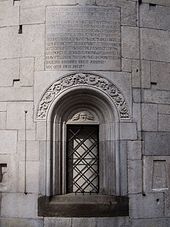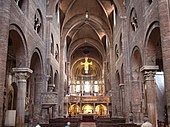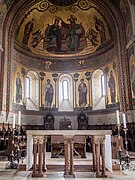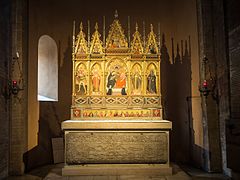Modena Cathedral
| Metropolitan Cathedral of Saint Mary of the Assumption and Saint Geminianus Cattedrale Metropolitana di Santa Maria Assunta e San Geminiano (in Italian) | ||
|---|---|---|
Year consecrated 1184 | | |
| Location | ||
| Location | Modena, Italy | |
| Geographic coordinates | 44°38′46.5″N 10°55′32.4″E / 44.646250°N 10.925667°E | |
| Architecture | ||
| Architect(s) | Lanfranco, Anselmo da Campione | |
| Style | Romanesque | |
| Groundbreaking | 1099 | |
| Completed | 1319 | |
Europe and North America | ||
Modena Cathedral (
History
Since the 5th century, two churches had existed on the site of the present cathedral: the discovery of the burial site of
Embellishment

After Lanfranco's work, the cathedral was embellished by Anselmo da Campione and his heirs, the so-called "Campionese-masters". The current façade therefore exhibits different styles. The majestic rose-window was added by Anselmo in the 13th century, while the two lions supporting the entrance's columns date to Roman times, probably discovered while digging the foundations.
Façade
The façade also has notable
The side portals are also noteworthy. On the Piazza Grande, the porta regia di piazza (piazza portal), also by the campionesi, and the porta dei principi (princes' portal), decorated with a relief depicting episodes of the life of Saint Geminianus, by a pupil of Wiligelmus. On the northern side is the porta della pescheria (fish market portal), with reliefs inspired by the cycle of the twelve months on the doorposts, and tales from the Breton Cycle of King Arthur on the archivolt.
Interiors

The interior is divided into three
The Duomo houses also the nativity scenes by two great Modenese artistis: Antonio Begarelli's one (1527) and, in the crypt, Guido Mazzoni's one (1480), also known as the Madonna della Pappa ("Madonna of the Pap").
The Torre della Ghirlandina is annexed to the church.
The funeral of the late famed tenor Luciano Pavarotti, a native of Modena, was held in the cathedral.
Porta della Pescheria
The cathedral's north portal, known as the Porta della Pescheria, features

The lintel carvings include a
At the center of the Modena Archivolt image is a castle defended by two towers, inside of which are two figures identified as "Mardoc" and "Winlogee". The left tower is defended by a pickaxe-wielding man named "Burmaltus", who faces off against
"Winlogee" most likely corresponds to Arthur's wife,
The knight Galvagin, the only one with a decorated shield, likely corresponds to Gawain, the hero of many romances. Gawain fights with a knight named Carados of the Dolorous Tower in the Vulgate Cycle (Lancelot-Grail) and Thomas Malory's Le Morte d'Arthur, based on the Vulgate. Further correspondences with material in the Vulgate also occur: notably, the Vulgate includes a scene in which Arthur, his nephew Galeshin, and his seneshal Kay attack Carados of the Dolorous Tower; the names of Arthur's companions are similar to the "Che" and "Galvariun" who approach Gawain on the Modena Archivolt. Loomis argued that the Archivolt scene corresponds to the Vulgate version of Guinevere's abduction, and that in an early version Gawain may have been the rescuer rather than Lancelot. Others have argued that the Modena image depicts the lost romance of Yder, or else the early stock version in which Arthur himself was the rescuer. Some others have argued that the image is not of Arthurian origin at all, though this is minority opinion.[2]
Gallery
-
Inside view
-
The crypt
-
The Apse
-
Main gate
-
West facade
-
Detail pulpit
-
Detail sarcophagus
Notes
References
- ISBN 0-8240-4377-4.
- Loomis, Roger Sherman (1927). Celtic Myth and Arthurian Romance. Columbia University Press.
External links
- The Modena Archivolt: photographs of the archivolt








